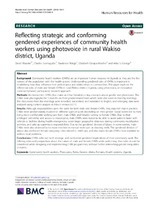| dc.contributor.author | Musoke, David | |
| dc.contributor.author | Ssemugabo, Charles | |
| dc.contributor.author | Ndejjo, Rawlance | |
| dc.contributor.author | Ekirapa-Kiracho, Elizabeth | |
| dc.contributor.author | George, Asha S. | |
| dc.date.accessioned | 2018-09-04T13:35:27Z | |
| dc.date.available | 2018-09-04T13:35:27Z | |
| dc.date.issued | 2018 | |
| dc.identifier.citation | Musoke, D. et al. (2018). Reflecting strategic and conforming gendered experiences of community health workers using photovoice in rural Wakiso district, Uganda. Human Resources for Health, 16: 41 | en_US |
| dc.identifier.issn | 1478-4491 | |
| dc.identifier.uri | http://hdl.handle.net/10566/4014 | |
| dc.identifier.uri | https://doi.org/10.1186/s12960-018-0306-8 | |
| dc.description.abstract | BACKGROUND: Community health workers (CHWs) are an important human resource in Uganda as they are the first
contact of the population with the health system. Understanding gendered roles of CHWs is important in
establishing how they influence their performance and relationships in communities. This paper explores the
differential roles of male and female CHWs in rural Wakiso district, Uganda, using photovoice, an innovative
community-based participatory research approach.
METHODS: We trained ten CHWs (five males and five females) on key concepts about gender and photovoice. The
CHWs took photographs for 5 months on their gender-related roles which were discussed in monthly meetings.
The discussions from the meetings were recorded, transcribed, and translated to English, and emerging data were
analysed using content analysis in Atlas ti version 6.0.15.
RESULTS: Although responsibilities were the same for both male and female CHWs, they reported that in practice,
CHWs were predominantly involved in different types of work depending on their gender. Social norms led to men
being more comfortable seeking care from male CHWs and females turning to female CHWs. Due to their
privileged ownership and access to motorcycles, male CHWs were noted to be able to assist patients faster with
referrals to facilities during health emergencies, cover larger geographic distances during community mobilization
activities, and take up supervisory responsibilities. Due to the gendered division of labour in communities, male
CHWs were also observed to be more involved in manual work such as cleaning wells. The gendered division of
labour also reinforced female caregiving roles related to child care, and also made female CHWs more available to
address local problems.
CONCLUSIONS: CHWs reflected both strategic and conformist gendered implications of their community work. The
differing roles and perspectives about the nature of male and female CHWs while performing their roles should be
considered while designing and implementing CHW programmes, without further retrenching gender inequalities
or norms. | en_US |
| dc.language.iso | en | en_US |
| dc.publisher | BMC | en_US |
| dc.rights | © The Author(s). 2018 Open Access This article is distributed under the terms of the Creative Commons Attribution 4.0
International License (http://creativecommons.org/licenses/by/4.0/), which permits unrestricted use, distribution, and
reproduction in any medium, provided you give appropriate credit to the original author(s) and the source, provide a link to
the Creative Commons license, and indicate if changes were made. The Creative Commons Public Domain Dedication waiver
(http://creativecommons.org/publicdomain/zero/1.0/) applies to the data made available in this article, unless otherwise stated. | |
| dc.subject | Community health workers | en_US |
| dc.subject | Photovoice | en_US |
| dc.subject | Roles | en_US |
| dc.subject | Gender | en_US |
| dc.subject | Males | en_US |
| dc.subject | Females | en_US |
| dc.subject | Health systems | en_US |
| dc.subject | Uganda | en_US |
| dc.title | Reflecting strategic and conforming gendered experiences of community health workers using photovoice in rural Wakiso district, Uganda | en_US |
| dc.type | Article | en_US |
| dc.privacy.showsubmitter | FALSE | |
| dc.status.ispeerreviewed | TRUE | |

